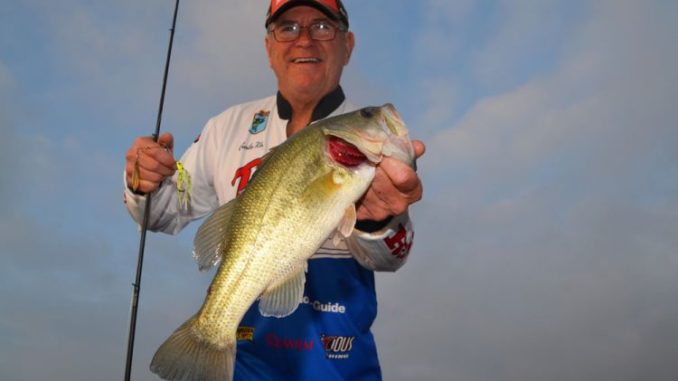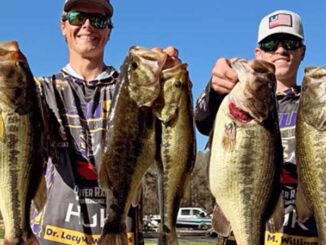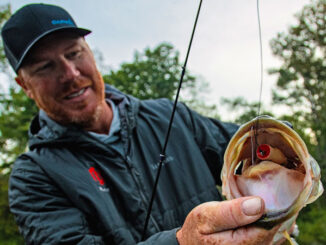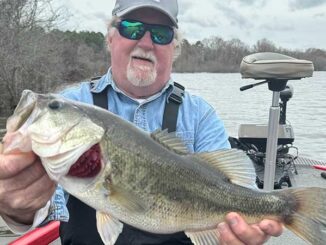
Catching fish isn’t necessarily the biggest challenge for visiting anglers on the Red River— but safe navigation is. Here’s how one local guide patrols the pools to catch plenty of largemouths.
Louisiana’s Red River used to be a mud hole.
Or at least, something close to it.
“It was shallow,” said 65-year-old Charlie King, of Charlie King’s Professional Fishing LLC, based in Ringgold (318-423-4280).
“You could wade across it,” agreed his fishing partner and friend Trent Toups (See this month’s Louisiana Seafood Bible column on page _____ for a sample of some of his superb cooking.)
“It was slack in the summer,” King went on. “With rain, it would become rolling, raging, red muddy — an unbelievably muddy river with strong currents. About the only fishing going on was catfishing.”
Then in the 10 years starting in November 1984, when Lock and Dam No. 1 was dedicated, through completion of Lock and Dam No. 5, the U.S. Army Corps of Engineers “tamed” the Red.
More than 200 miles of the river from Lower Brouillette to Shreveport turned from red to green and water levels were stabilized and raised, flooding large areas. The five locks and dams were created strictly for navigational purposes — to make Shreveport into a functional river port.
“The Corps of Engineers channelized the river,” explained King. “They cut off a lot of the twists and loops in the river, effectively straightening it out. Each of the five locks and dams created a lake called a ‘pool.’
“The lock and dam structures are numbered from the bottom to the top. Number 1 is near Marksville, No. 2 is below Alexandria, No. 3 is at Natchitoches, No. 4 is at Coushatta and No. 5 is close to Shreveport-Bossier.
“Each pool is a lake now, and each pool is 12 or 13 miles long. Some current still exists in the river itself, but very little or none is in the flooded backwaters.”
Normal water clarity in flooded backwaters is 1 foot, which King explained is good for bass. Sometimes the river itself is clearer than the backwaters around it, with visibilities of 2 or 3 feet.
His theory is that algae blooms are more likely to occur in stiller backwaters than in the moving river. But he cautioned that clarity in the system can change quickly, depending on rainfall runoff, as well as winds that stir waters over shallow mud flats.
“If you look at an aerial photograph, you will see four or five different colors of water in one pool.”
Bass heaven
The barges never came in the numbers hoped for, but what did come was a world class largemouth bass fishery — one good enough to attract the Bassmaster Classic in 2009 and again in 2012.
And also good enough to start King’s guiding business.
He started fishing the river one year after the first lock and dam was built. “They didn’t even have a boat ramp then,” he smiled. “We had to launch an aluminum boat off the bank.”
Both men agreed that they considered the Red River to be one of the best bass spots in the country. “That’s why so many tournaments were held here,” Toups said. “It was a major fishery.”
“We were blessed after the locks and dams were built,” said King, “with five or six years of low rainfall. This produced great spawns. Sometimes 20-pound (five-fish) bags would barely get you into the Top 10 in a tournament.
“Hundred-fish days were so common that it was bizarre. This went on 10 years.
“The normal cycle is three or so wet years and then three or so dry years. That’s river fishing — I don’t care where you fish.”
And then …
“Then came the big floods,” groaned King.
“We had a 100-year flood in 2015, a 500-year flood in 2016 and 8-foot-high flooding three times in the summer of 2017.
“We lost 50 percent of our fishable waters — silted in. Water that was 20 feet deep became 3 feet deep. Washed out all our vegetation: lily pads, coontail fields, hydrilla beds and hyacinths.
“Toppled over wing dams and the rock walls that run parallel with the bank. These made navigation dangerous. All the buoys marking the ends of rock walls were washed away.
“The one thing we didn’t lose was our woody cover.”
“But there’s still bass here — lots of them,” interrupted Toups. “Fishing here is a chance to fish a river system. It’s different than fishing reservoirs.”
“It’s like The Wild Kingdom,” chuckled King.
“All your major tournament circuits hold tournaments here, year round, from Ultimate Bass Team Tour to the Bassmaster Classic. And the Bass Pro Shops Bassmaster Opens, the Costa FLW Series and the Skeeter Bass Champs.
“A lot of my guiding business comes from people practicing for tournaments on the Red.
“I’m a Red River booster. I want to showcase the river — to show people that the fishing is still good. We’ve had all kind of bad press about the floods.”


